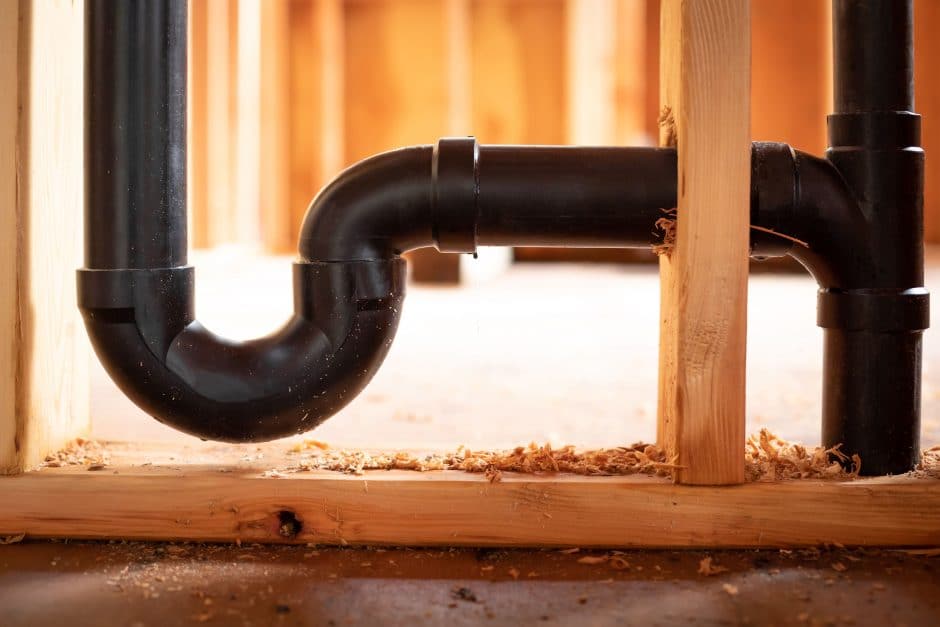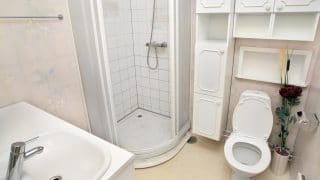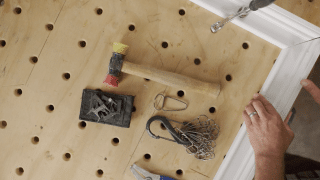
Drain traps like P-traps and S-traps keep sewer gases from entering your home or building by trapping a small amount of water in the drain line. This water keeps sewer gases and pests from entering the plumbing system as well. There are several types of drain traps: floor drain traps, gully traps, bottle traps, and grease traps. The most common are S-traps and P-traps.
What is an S-trap?
S-traps are a type of plumbing trap that blocks sewer gases in sinks and other plumbing fixtures. The S-shaped pipe configuration traps wastewater before it drains to the sewer line, creating a water seal that prevents gases from flowing up through the drain. P-traps were common in the early 20th century, though they are no longer in use. When a large amount of water flows through the S-trap, it can create too much suction and pull water out of the trap and leave it dry. The dry trap creates an air gap, drawing sewer gases into the building.
S-traps are no longer allowed in modern plumbing code. Most, if not all, jurisdictions in the United States have banned the use of S-traps in new construction, and any S-traps in older buildings are to be replaced by P-traps.
What is a P-trap?
A P-trap is a U-shaped piping configuration, similar to an S-trap. The drain collects water in the U portion, creating a barrier that prevents sewer gases from entering the building. The addition of a vented pipe prevents siphoning and the waste arm extension helps reduce suction in the drain.
P-traps are approved for all new plumbing installations. They don’t totally eliminate the chance of a dry trap, but there is less chance of this occurring with a P-trap than an S-trap. If a fixture isn’t used often, you may need to run water through it to refill the trap.
How to convert an S-trap to a P-trap
Most jurisdictions banned the S-trap from new plumbing installations several decades ago. S-traps drain too much water which leaves an air gap in the trap thereby allowing gasses to flow through the system. P-traps, which replaced S-traps, have a similar configuration with the addition of a vent and drain line. Converting an S-trap to a P-trap involves installing a vent pipe within AAV and a waste arm extension that connects the trap to the vent pipe and drain line. There are two parts to a P-trap conversion: vent piping and a waste arm extension.
Drain traps like P-traps and S-traps keep sewer gases from entering your home or building by trapping a small amount of water in the drain line. This water keeps sewer gases and pests from entering the plumbing system as well. There are several types of drain traps: floor drain traps, gully traps, bottle traps, and grease traps. The most common are S-traps and P-traps.
What is an S-trap?
S-traps are a type of plumbing trap that blocks sewer gases in sinks and other plumbing fixtures. The S-shaped pipe configuration traps wastewater before it drains to the sewer line, creating a water seal that prevents gases from flowing up through the drain. P-traps were common in the early 20th century, though they are no longer in use. When a large amount of water flows through the S-trap, it can create too much suction and pull water out of the trap and leave it dry. The dry trap creates an air gap, drawing sewer gases into the building.
S-traps are no longer allowed in modern plumbing code. Most, if not all, jurisdictions in the United States have banned the use of S-traps in new construction, and any S-traps in older buildings are to be replaced by P-traps.
What is a P-trap?
A P-trap is a U-shaped piping configuration, similar to an S-trap. The drain collects water in the U portion, creating a barrier that prevents sewer gases from entering the building. The addition of a vented pipe prevents siphoning and the waste arm extension helps reduce suction in the drain.
P-traps are approved for all new plumbing installations. They don’t totally eliminate the chance of a dry trap, but there is less chance of this occurring with a P-trap than an S-trap. If a fixture isn’t used often, you may need to run water through it to refill the trap.
How to convert an S-trap to a P-trap
Most jurisdictions banned the S-trap from new plumbing installations several decades ago. S-traps drain too much water which leaves an air gap in the trap thereby allowing gasses to flow through the system. P-traps, which replaced S-traps, have a similar configuration with the addition of a vent and drain line. Converting an S-trap to a P-trap involves installing a vent pipe within AAV and a waste arm extension that connects the trap to the vent pipe and drain line. There are two parts to a P-trap conversion: vent piping and a waste arm extension.
- The P-trap must tie into a vent pipe to prevent siphoning. If there isn’t a vent stack nearby, you can use an air admittance valve, or AAV. An AAV is a one-way valve that vents air in but doesn’t let sewer gas out. Install the AAV at the top of a short vent pipe near the fixture and be sure to place it above the level of the fixture’s drain.
- The second step is adding a waste arm extension to the drain line. Its length needs to be two to 2 ½ times the diameter of the pipe to eliminate siphoning. For example, a 1 ½ inch pipe needs at least a 3 ¾-inch waste arm extension.
- Once the waste arm and vent pipe are installed, the P-trap is connected to the fixture’s drain line, then to the waste arm connection. The waste arm connects to the vent and drain line via a wye connection.
MT Copeland offers video-based online classes that give you a foundation in construction fundamentals with real-world applications, like plumbing basics. Classes include professionally produced videos taught by practicing craftspeople, and supplementary downloads like quizzes, blueprints, and other materials to help you master the skills.







